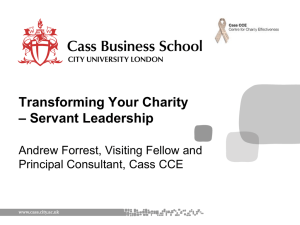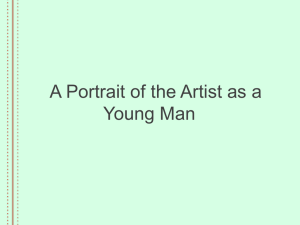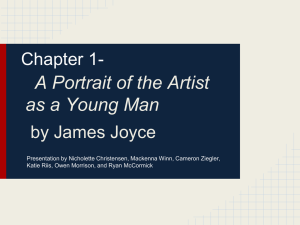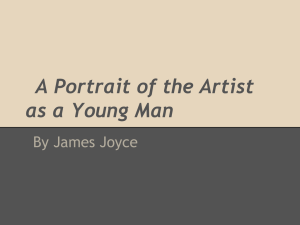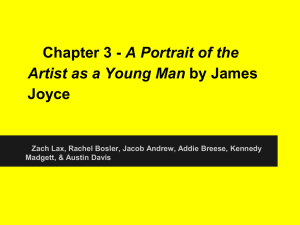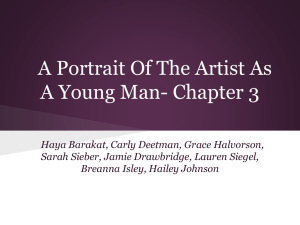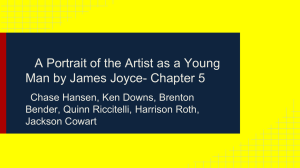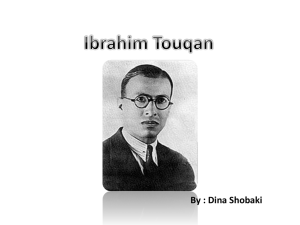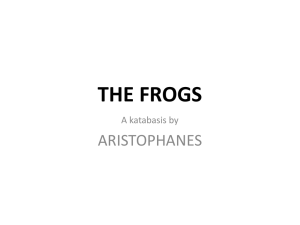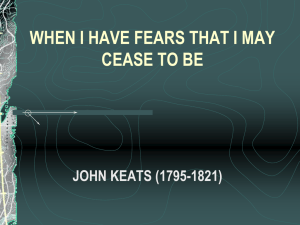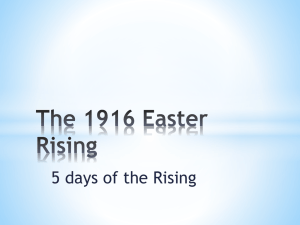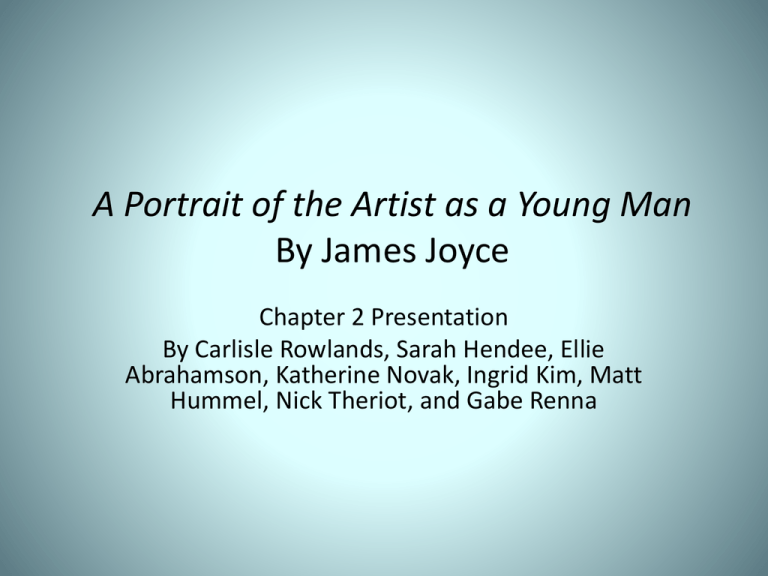
A Portrait of the Artist as a Young Man
By James Joyce
Chapter 2 Presentation
By Carlisle Rowlands, Sarah Hendee, Ellie
Abrahamson, Katherine Novak, Ingrid Kim, Matt
Hummel, Nick Theriot, and Gabe Renna
Chapter 2 Summary
Stephen and his family move to a new house in Blackrock, a
small town outside Dublin. Stephen spends most of his
summer with his Uncle Charles who constantly smokes. He
still struggles with the idea of religion and is confused when
he goes to church with his uncle because he doesn’t seem
to fit in with what Stephen has been taught about religion.
He is happy to be home for the summer and makes his first
real friend, Aubrey Mills. As summer ends, Aubrey returns
to school but Stephen doesn’t because of financial reasons.
Stephen and his family move to a small house in Dublin,
and Stephen’s father works out a deal with the headmaster
for Stephen and his brother to attend Belvedere.
Chapter 2 Summary (cont)
Stephen takes a walk outside just before he goes onstage before
a school play. He runs into Heron and another boy that used
to bully him, causing him to remember the time he was
accused of heresy. He then wonders about a girl from his
neighborhood that has come to see him in the play.
Stephen and his father are on a train going to cork. His father is
very nostalgic and keeps trying to connect with Stephen, but
Stephen can’t seem to relate. Stephen passively follows his
father around and is distracted by the idea of death which
leads him to think about the death of his childhood. Back in
Dublin, Stephen spends all his money he won in a contest on
gifts for himself and others. The chapter ends when Stephen
encounters a prostitute while wandering the streets of Dublin.
Sensory Experiences
As Stephen gets older, he begins to be able to communicate his
thoughts more easily and relies less on his senses. He still
seems to be more aware of his senses than the average boy
his age, and the things he notices only help to show how
different he is from the other children. He seems to pay extra
attention to sounds saying, “The noise of children annoyed
him and their silly voices made him feel…that he was different
from the others” (74). As Stephen grows, he has the ability to
interpret his senses and attach meaning to them. We see him
grow through his changing interpretation of the world around
him.
Perceived Hypocrisy and Betrayal of
Catholicism
• In this passage the perceived hypocrisy and betrayal of
Catholicism is evident when Stephen is accused of heresy in
an essay by Mr. Tate.
• “Here. It’s about the Creator and the soul. Rrm… rrm…
rrm… Ah! without a possibility of ever approaching nearer.
That’s heresy”(88).
• Mr. Tate calls out Stephen for betraying a Catholic belief,
and even though Stephen tries to explain that he meant to
say: “without a possibility of ever reaching” (88). This
excuse does not satisfy Mr. Tate who still shows no apathy,
which is not what a devout Catholic would do because they
are suppose to be accepting of others.
Evaluation/Establishment of Identity
• Stephen begins to develop an identity as an outcast
because almost all of his beliefs and opinions differ from his
classmates, and over the chapter he begins to embrace the
fact that he is different and becomes more comfortable
with it.
• “—And who do you think the greatest poet? asked Boland
,nudging his neighbor. –Byron, of course, answered
Stephen. Heron gave the lead and all three joined in a
scornful laugh” (90).
• Stephen is confident enough to express his opinions, even
though they differ from his classmates and is made fun of
fordoing so. He is not ashamed to express himself, which is
demonstrates he has more confidence and is also more
comfortable with his unique identity as a sort of an outcast.
Isolation/Differentness/Weakness
• “The noise of children at play annoyed him and their silly voices
made him feel, even more keenly than he had felt at Clongowes,
that he was different from others” (74).
• Stephen begins to realize that he is different and has an unique
perception of life that separates him from most of the other kids.
His desire to form his own identity pushes him towards isolation.
• “He wanted to meet in the real world the unsubstantial image
which his soul so constantly beheld… They would be alone,
surrounded by darkness and silence: and in that moment of
supreme tenderness would be transfigured “(74-75).
• In this statement Stephen concludes that he is different from
others, and ultimately belongs in an alternate world. He describes
the new world as accepting and a place where differentness would
disappear.
Isolation/Differentness/Weakness (cont)
• “He saw clearly too his own futile isolation. He had not
gone one step nearer the lives he had sought to
approach nor bridged the restless shame and rancour
that divided him from mother and sister. He felt that he
was hardly of the one blood with them but stood to
them rather in the mystical kinship of fosterage,
fosterchild and fosterbrother”(106-107).
• Stephen displays feelings of extreme isolation after
spending the evening with his father, and at this point
his emotions get the better of him and he is
overwhelmed with shame.
Water imagery
• Similar to chapter 1 water mainly serves as a means of
portraying Stephen’s emotional state. For example when
Stephen describes the yellow scummy water of the Dublin
harbor to convey how he is upset with his move to Dublin as
well as his family’s overall status.
Water (cont)
• Other references to water include the holy water
from the font of the church.
• “The font was above his reach, the old man would
dip his hand and then sprinkle the water briskly
about Stephen’s clothes and on the floor” (42).
• In this case the holy water is used to show Stephen’s
state of personal inadequacy, and relative inability to
embrace religion.
Bird imagery
• While birds aren’t necessarily referenced
directly, their significance to the story is
developed through Stephen’s friend Heron.
Stephen compares heron to a bird because of
his name and appearance.
• Throughout the chapter Heron and Stephen
have little disagreements, which show
personal growth and independence for
Stephen compared to chapter one.
Bird cont.
• “This spirit of quarrelsome comradeship which he
had observed lately in his rival had not seduced
Stephen from his habits of quiet obedience.” (58)
• While Stephen acknowledges a personal change,
it is still evident that he is bound by old habits.
The fact that he associates this personal change
with seduction helps elaborate on the overall
crossroads that Stephen finds himself in
throughout the chapter.
Maze labyrinth
• The maze is used to summarize
Stephen’s emotional struggles
at the end of the chapter. As he
contemplates his fear of his
desire for love and lust.
• As he walks the streets he finds
himself in a maze of streets
where he ultimately breaks
free.
Stephen’s Alternating Faith and Doubt
in God and Catholicism
•
•
•
In Chapter two, the pressure to be a good gentleman and a good Catholic is
evident in his conversations with his father and his father’s friends.
“While his mind had been pursuing its intangible phantoms and turning in
irresolution from such pursuit he had heard about him the constant voices of his
father and of his masters, urging him to be a gentleman above all things and urging
him to be a catholic above all things. These voices had now come to be hollowsounding in his ears” (92).
Stephen is constantly surrounded by Catholicism from his family members,
classmates, and teachers. He feels that he is always listening to stories and
accounts that “he had heard before” (99). The constant repetition and pressure to
fit in with the Catholic society makes the material exhausting and not as important
to Stephen. The material is “hollow-sounding” because it holds no value for him.
Stephen’s Desire to Escape
•
•
•
Stephen feels very isolated from his peers and the people around him. His desire
to escape is clear from his thoughts about how different he is from others.
“The noise of children at play annoyed him and their silly voices made him feel,
even more keenly than he had felt at Clongowes, that he was different from the
others. He did not want to play. He wanted to meet in the real world the
unsubstantial image which his soul so constantly beheld” (74).
Stephen has felt different from his peers from the beginning of the novel, but he
feels increasingly isolated as he gets older. He refers to the children’s voices as
“silly,” suggesting that he feels superior and more mature than them. Stephen has
this “image” in his head of what he wishes his life was like and he wants to escape
to “the real world” to meet it. He wants to escape the path that will shape him
into the mold that his family and society has created for him.
References to Literature and Writing
• Among Stephen’s references to literature and
writing in Chapter 2, he mentions The Count of
Monte Cristo by Alexandre Dumas. He reads in
the evening to escape reality, pretending to be in
love with Mercedes, the heroine of The Count of
Monte Cristo, and acts out forays and battles on
the rocks from the novel with his friend, Aubrey
Mills. This event is significant because it
demonstrates Stephen’s feelings toward his
family; he feels ashamed of his father’s
management of the family’s finances, so he uses
his imagination to conjure up a better life.
References to Literature and Writing (cont)
• In addition to The Count of Monte Cristo, Stephen also refers to his
favorite poet, Lord Byron. He looks up to him when he attempts to
write a love letter, claiming that “he knew it was right to begin for
he had seen similar titles in the collected poems of Lord Byron” (7980). Stephen also mentions Byron when he recalls the day when his
peers (Heron, Boland, and Nash) asked him who his favorite poet
was. Heron mocked him when he chose Byron over Lord Tennyson,
claiming that Byron’s “a heretic and immoral” and that “he’s only a
poet for uneducated people” (90). Stephen demonstrated a change
in character by sticking up for himself and his beliefs, refusing to
admit that “Byron was no good” (91) no matter what his friends did
to him. This event demonstrates Stephen’s dedication to his
opinions. As a writer himself, he refuses to let anybody bring him
down for what he believes about literature and writing.
Significance of Literature and Writing
• Since Stephen is a successful writer himself, even receiving money for
“his exhibition and essay prize” (105), literature and writing play a
significant role in his life throughout Chapter Two and the rest of A
Portrait of the Artist as a Young Man. Joyce utilizes Stephen’s
references to literature and writing in order to showcase his own
development as a person and as a writer. In Chapter Two specifically,
Stephen acts out scenes from The Count of Monte Cristo, representing
Joyce’s love for reading as a child and how he similarly found reading
to be an outlet from reality. As Stephen grows up, we see him begin
to write his own poetry (the love note), signifying the beginning of
Joyce’s transformation from a young man into an artist. Finally,
Stephen sticks up for himself for the first time when his peers make
fun of him for liking Lord Byron, further signifying Joyce’s
transformation into an artist.
• Stephen is still struggling with the isolation and weakness that he
dealt with in Chapter One, but he demonstrates signs of growth after
sticking up for himself for the first time. He knows that he’s different
from others and begins to realize that he must accept himself.
Relationship with Family/Community
• Stephen’s relationship with his family always seems to lead to
instability and unhappiness. Stephen begins to realize that his
father’s financial troubles are the reason for him not returning to
Clongowes and feels like the recent changes in the home are “slight
shocks to his boyish conception of the world” (74). His realizations
are assured when the family moves to Dublin in order to save
money, leaving him in a mood of “embittered silence” (76).
• Stephen’s detachment from his family and community can be seen
throughout Chapter Two. For example, instead of playing with the
children at his aunt’s house during the children’s party, Stephen
decides to sit alone and “taste the joy of his loneliness” (78). He
also fails to build healthy relationships with his peers at his new
school because he doesn’t participate in the same activities that
they do, like smoking, and often disagrees with them on topics like
religion and poetry. Stephen’s friends also seem to constantly tease
and hurt Stephen for his actions, causing him to suffer from
violence like “cuts of the cane” and “blows from the knotty stump”
(91).
Relationships with Family/Community (cont)
• The words of Stephen’s father and masters “urging him to be a gentleman
above all things and a good Catholic above all things” (92) and the words
of his school comrades “urging him to be a decent fellow” (93) have all
come to be “hollow-sounding voices” (93). He’s only happy when he’s
alone and far away from them, again demonstrating his isolation from
society.
• When Stephen goes to Cork, he fails to connect with his father and his
father’s friends because they possess a youthfulness that he has never had
– “No life or youth stirred in him as it had stirred in them” (104).
• Stephen attempts to bring his family together after winning prize money
for an essay by buying all sorts of gifts, but after the money is spent, the
household returns to normal. He sees his “futile isolation” (106) from his
family too clearly and feels like he is “hardly of the one blood with them”
(107). He stands to them “rather in the mystical kinship of fosterage,
fosterchild, and fosterbrother” (107).
Stephen’s Perception of Love and Sex
• Throughout the chapter we see Stephen have a few encounters
with women that pertain to his emotions. The early ones are very
brief and have not much meaning but Stephen meets a girl with
black stockings at a kids party. He has a little interaction with her
and talks to her on a tram ride home. He has a small inkling of
having contact with her, but suppresses it because of what he has
been taught. “I could hold her and kiss her. But I did neither:” (79)
After this encounter we see little of Stephen interacting with
women until the end of the chapter. In the end of the chapter we
see Stephen give into his “animalistic” instincts when he meets a
“young lady in a long pink gown” and kisses her. “He closed his
eyes, surrendering himself to her” (109)
The Count of Monte Cristo
• An adventure story written by Alexandre Dumas. The story is about a
young sailor, Edmond Dantes, who is set to become successful but is then
sent to jail by jealous colleagues and enemies. During his imprisonment,
his cell neighbor befriends him and educates him and then reveals to
Dantes the location of a massive treasure when he is on his death bed.
Dantes then finds the treasure after escaping the prison and buys a boat,
the island with the treasure on it, and the title of Count. The Count then
pursues vengeance against the people that imprisoned him after helping a
few people. He relieves his old employer of all of his debts which prevents
the man from suicide. Then he bankrupts Mr. Danglers, a friend who’s
jealousy over Dantes’ success led him to help in imprisoning Dantes. After
Fernand, a man who also helped imprison Dantes because he wanted
Mercedes for himself, is tried for selling people into slavery his wife and
son, Mercedes and Albert, disown him and after learning the Count is
Dantes, commits suicide. Mr. Danglers then tries to escape with what little
fortune he has left, but is caught by the Count’s assistant. Mr. Danglers is
then held and forced to pay high prices for food and after almost paying
all of his money away, is let go. Finally, the Count leaves his fortune to a
young couple he saved from suicide and leaves with his new lover Haydee.
Count of Monte Cristo: Connections
• Stephen has become very fond of the book The Count of Monte Cristo and
starts to identify with certain characters. He especially likes to think of
himself as the romancer of Mercedes, the beautiful woman who men fight
over in the novel as he becomes more involved in growing up and love.
• Also as his summer progresses he imagines himself and his new
companion Aubrey Mills in scenarios from The Count of Monte Cristo
because he is trying to associate with the book as he grows up. They play
out scenes or scenarios from The Count all summer.
• Finally, as his family has moved and less of his parents attention is devoted
to Stephen, he wanders through the city and docks still relating himself to
the Count in his reading.
Cardinal Newman
• An important figure in the religious history of England in the
19th century.
• -Who is the greatest writer, Dedalus?
• -Newman, I think.
• -Is it Cardinal Newman?
• -Yes.
• Analysis
Stephen realizes that he is being mocked by the other boys.
When they ask him who the greatest writer is, Stephen tries
to fit in by saying Cardinal Newman. He felt like an outcast
earlier in the chapter when he was accused of heresy so he
told the boys what he thought they wanted to hear.
Lord Byron
• 1788-1824
• Scottish poet and a leading figure in the
Romantic movement
• Known for huge debts, numerous love affairs,
including one rumored to be with his halfsister
• May have suffered from bipolar disorder of
manic depression
Lord Byron Connection to Text
• -“In any case Byron was a heretic and immoral too.”
-“I don’t care what he was”
- “You don’t care whether he was a heretic or not?”
- “What do you know about it? You’ve never read a line of
anything in you r life except a tans.”
Analysis
Stephen is once again an outcast. While the other boys believe
Tennyson is the superior poet, simply because that is what
they have in there homes, Stephen believes the dark heretic
poet, Byron is superior. Stephen does not care that Byron may
be a heretic. He does not understand religion and is finally
speaking for himself.
Alfred Lord Tennyson
• Alfred Lord Tennyson was born on August 6th, 1809.
• The success of his 1842 Poems made Tennyson a popular p
oet, and in 1845 he received a generous government pensi
on which helped relieve his financial difficulties.
• “The Princess” and In Memoriam also helped establish his t
itle as the most popular poet in the Victorian era (period of
Queen Victoria’s reign from June 20, 1837 until her death o
n January 22, 1901).
• In the text, Stephen, Heron and his friends are arguing over
who they think is the best poet. “And who is the best poet,
Heron?” asked Boland. “Lord Tennyson, of course, answere
d Heron. “Everyone knows Tennyson is the greatest poet.” (
pg. 89-90)
The Confiteor
• A Catholic prayer said at the beginning of Mass
• Literally means, “I confess”
• In text: “While he was still repeating the Confiteor amid
the indulgent laughter of his hearers...” (pg. 91)
• The boys are still in a heated discussion over who the b
est poet is. As the argument continues, Nash and Bolan
d (Heron’s friends) beat Stephen and try to force him in
to agreeing that ‘Byron is no good’. Stephen eventually
frees himself but finds that he is ‘half blinded with tear
s, clenching his fists madly and sobbing’. However, after
saying the prayer, his anger dissipates.
Chapter 2 Quiz
1. Who does Stephen think is the greatest poet
of all time?
a.
b.
c.
d.
Tennyson
Shakespeare
Byron
Newman
2. Who does Stephen spend most of his time
with in the beginning of Chapter 2?
a. Mr. Dedalus
b. Uncle Charles
c. Heron
d. His mom
3. Stephen imagines himself as the lover of
whom in The Count of Monte Cristo?
a. Mercedes
b. Fernand
c. Edmond
d. Florence
4. What does Mike Flynn try to teach Stephen to
do?
a. Shoot a gun
b. Play chess
c. Run
d. Sing
5. To whom does Stephen write his first love
poem?
a. “E-C”
b. “R-V”
c. “C-V”
d. “E-B”
6. Which character smokes “black twists” of
tobacco?
a. Mr. Dedalus
b. Mike Flynn
c. Mr. Casey
d. Uncle Charles
7. Why is Stephen Embarrassed of his father
when they visit Cork?
a. Simon gets drunk
b. Simon gets into a fight at a bar
c. Simon treats Stephen like a child
8. What does Stephen do to win prize money?
a. He wins an essay prize
b. He has the highest test scores in his class
c. He wins a race
9. What is Stephen accused of in his school
essay?
a. Stupidity
b. Catholicism
c. Heresy
d. Love
• 10. What animal does Heron resemble?
a. Dog
b. Moose
c. Bird
d. Bear
Quiz Answers
1. C
2. B
3. A
4. C
5. A
6. D
7. A
8. A
9. C
10. C


